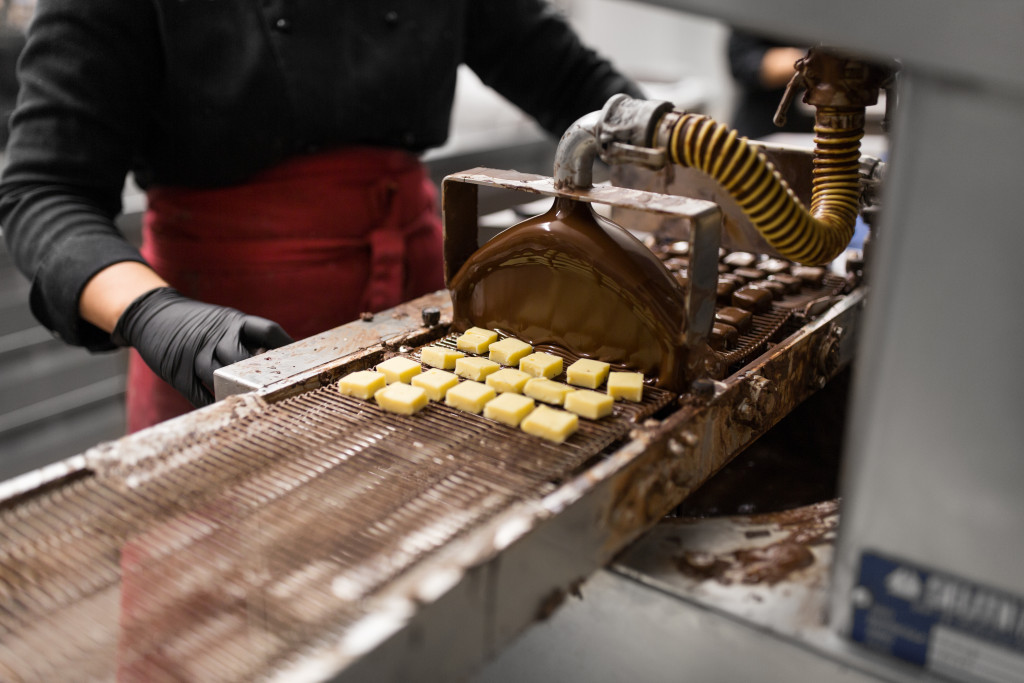- Conduct market research to identify potential customers & competitors.
- Develop recipes and skills for producing unique products.
- Decide on a business model (e.g. B2B, B2C, D2C, Hybrid).
- Find suppliers and equipment such as melting and tempering machines, molds, and cooling tables.
- Develop a strong brand and marketing strategy to stand out in the industry
There’s no denying that the chocolate industry is an incredibly lucrative one. It’s no surprise that many entrepreneurs are jumping in and starting their chocolate manufacturing businesses.
However, starting a chocolate manufacturing business comes with its unique challenges. This blog post will discuss how to get started with a chocolate manufacturing business and some of the things you need to consider.
Conduct Market Research
The first step in starting any business is market research. You need to know if there is demand for your product, who your competitors are, and what makes your chocolate unique. Look at market trends and see what types of chocolate are selling well and where. You can even conduct surveys to gauge potential customer interest in your product. This information will help you develop a business plan and guide your decision-making.
Develop Your Recipes and Skills
Before selling chocolate, you must develop your recipes and skills. You can take courses, read books, or work with a chocolatier to learn how to make chocolate. Try different recipes and techniques until you find what works for you. Don’t be afraid to experiment with different flavors and textures, too. This will help you create a unique product that stands out from the competition.
Decide on Your Business Model

One crucial decision you have to make is your business model. It will determine how your business operates, how you generate revenue and your overall success rate. Your business model influences everything from how you deliver the product to how the product benefits your customers. Here are the top 4 business models you can choose from for your chocolate manufacturing business.
B2B (Business to Business)
A B2B business model primarily sells products to other businesses. As a chocolate manufacturer, you can supply your products in bulk to other chocolate shops, cafes, and bakeries. One of the advantages of this model is that you have a steady client base that places orders regularly.
However, it means less exposure to the end consumer, and you may need high minimum order volumes. Additionally, you will have to diversify your product line to ensure they meet the demands of your clients, and you may have to lower prices to compete.
B2C (Business to Consumer)
The most common business model for most chocolate manufacturers is the B2C approach. It involves selling directly to the end consumer via retail locations, online platforms, or door-to-door sales.
This approach involves a lot of branding and marketing of your products to create strong customer loyalty. You need to spend more time and resources creating a brand that resonates with your customers. It might also require investment in customer service, logistics, and distribution.
D2C (Direct-to-consumer)
This model involves selling directly to your customers through your channels. You bypass the need for intermediaries like retailers or distributors. Direct-to-consumer models offer a high level of personalization, convenience, and control over the production process. It gives you more control over your pricing, inventories and eliminates intermediaries.
Hybrid model
The hybrid model involves combining two or more business models, such as offering B2C products through online stores and B2B products through trade shows or fairs. The hybrid model gives you the advantages of both models and helps spread your risk. Hybrid models require diversification in resources, product lines, and distribution channels.
Find Suppliers and Equipment
Once you have your recipes and business model, it’s time to find suppliers and equipment. You’ll need to source ingredients, packaging, and other supplies. You’ll also need to invest in equipment, such as melting and tempering machines, molds, and cooling tables.
Aside from these basics, consider purchasing durable pearlitic chrome-moly steel liners for AG mills. These are used to ensure the efficient grinding of chocolate during production and can help you produce higher-quality products more quickly and efficiently.
Develop Your Brand and Marketing Strategy

Finally, you need to develop your brand and marketing strategy. Your brand should reflect the unique qualities of your chocolate, such as flavor, texture, and origin. You should also identify your target market and create a marketing strategy that reaches them. This can include social media, email marketing, influencer partnerships, and more. Creating a strong brand and marketing strategy to stand out in the crowded chocolate industry is important.
Final Thoughts
Starting a chocolate manufacturing business is no easy feat, but with these tips, you’ll be well on your way. Remember to conduct market research, develop your recipes and skills, decide on your business model, find suppliers and equipment, and develop your brand and marketing strategy. With dedication and hard work, you can create a successful chocolate manufacturing business that brings joy to chocolate lovers everywhere.

